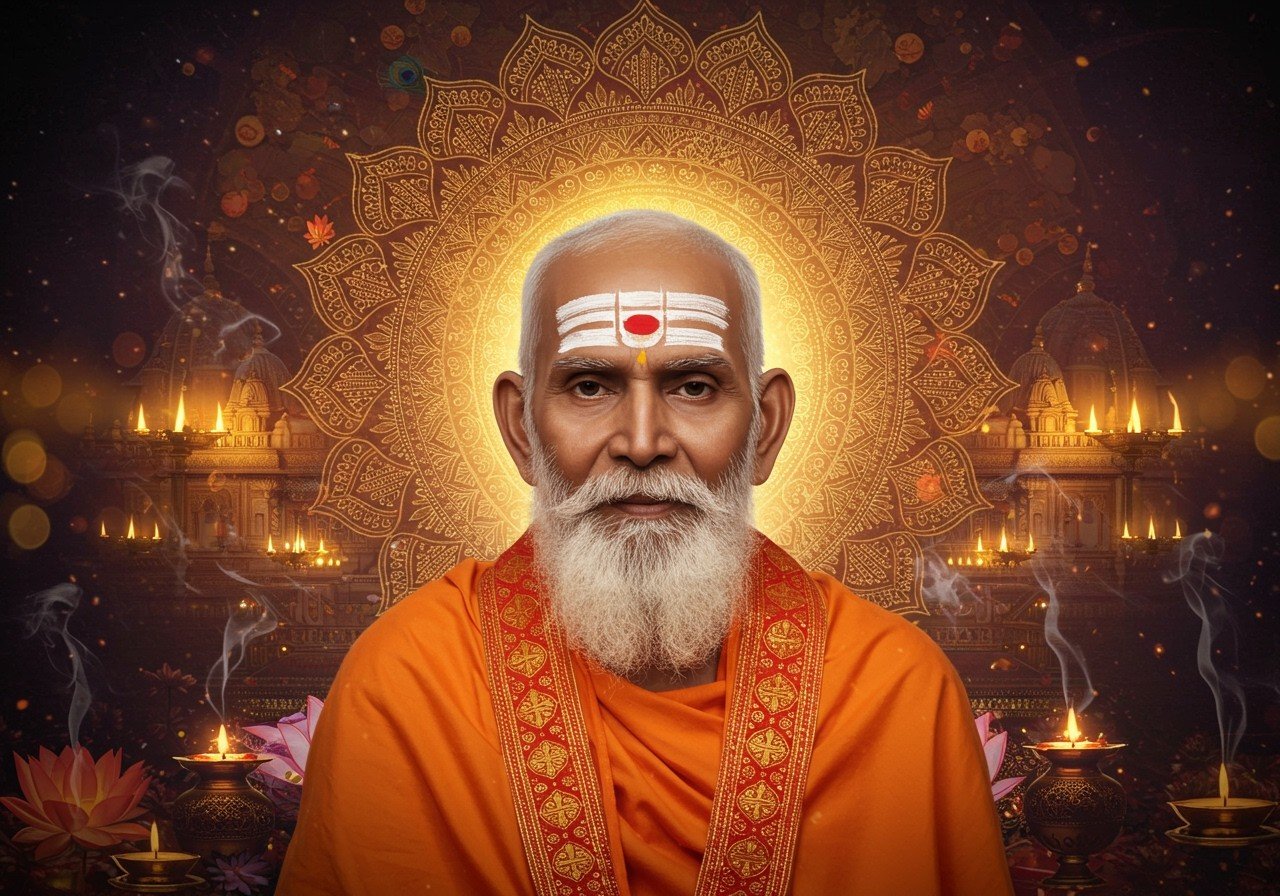
In the rich tapestry of Hindu traditions, Vaishnavism occupies a prominent position. This major sect centers around the reverence of Vishnu and his various incarnations. Among its diverse spiritual practices, the tilak stands out as a significant symbol of devotion. Nimbarkacharya, a respected philosopher, played a vital role in shaping the Nimbarka Sampradaya. His teachings and the unique tilak associated with his followers carry profound cultural and spiritual meaning.
The Historical Context of Nimbarkacharya
Nimbarkacharya is believed to have lived between the 11th and 12th centuries CE. He was instrumental in developing the Dvaitadvaita philosophy, a concept that emphasizes both the oneness and distinction between the individual soul and the divine. This dualistic non-dualism forms the core of his philosophical perspective. Nimbarkacharya founded the Nimbarka Sampradaya, extending its influence throughout India. His contributions are documented in texts such as the ‘Vedanta Parijata Saurabha,’ which outlines his philosophical viewpoints. Through these teachings, Nimbarkacharya left a lasting legacy on Vaishnavism, offering guidance to numerous devotees on their spiritual paths.
Nimbarkacharya’s Tilak: Design and Significance
The Nimbarka tilak holds deep symbolic meaning for members of the Nimbarka Sampradaya, a vibrant branch within Vaishnavism. This tilak is crafted using Gopi-Chandana, a specific type of clay sourced from the sacred Gopi Kunda lake located in Dwarka, Gujarat. Its design features two vertical lines originating at the bridge of the nose and rising to the forehead, symbolizing the sacred temple of God. Nestled between these lines is a black dot, fashioned from slate obtained from Barsana, Uttar Pradesh – the birthplace of Radha.
The symbolism embedded within the tilak is profoundly rooted in devotion. The vertical lines signify the divine temple, a sacred space where devotees connect with the divine. Meanwhile, the black dot embodies the unified essence of Radha and Krishna, visually representing the core belief of Nimbarkacharya’s followers: that God is a singular, unified entity of Radha and Krishna. This representation highlights the intimate connection between the divine couple and their devotees.
The Role of the Nimbarka Tilak in Devotional Practices
Applying the Nimbarka tilak transcends mere ritual; it’s a daily spiritual practice imbued with deep meaning. The journey begins with the guru bestowing the tilak upon the initiate during the initiation ceremony, marking a pivotal moment in the devotee’s spiritual life. Subsequently, followers apply the tilak daily, not just as a routine, but as a conscious act of remembrance of their guru’s teachings and an affirmation of their identity within the Nimbarka Sampradaya. This daily practice reinforces their connection to the lineage and its spiritual values.
The act of applying the tilak goes beyond its visual aspect. It is applied to the forehead, the location of the “ajna chakra” or “third eye,” a point traditionally considered the seat of wisdom and intuition. The application of the tilak to this area is believed to promote calmness within the mind and body, creating an inner space conducive to spiritual contemplation. This seemingly simple act fosters a deeper connection with one’s faith, promoting a sense of peace and purpose.
In communal gatherings and ceremonies, the tilak acts as a visible marker of shared beliefs, fostering a sense of unity and belonging within the community. The use of natural materials like sandalwood paste or clay preserves ritual purity and reinforces the link between personal spirituality and communal faith, connecting the individual’s practice with the broader spiritual tradition.
Cultural Relevance and Modern Interpretations
In contemporary times, Nimbarkacharya’s tilak continues to hold relevance, especially for culturally rooted Indians who cherish traditional practices. This enduring significance extends into modern contexts, reaching younger generations through digital platforms and online communities. These virtual spaces offer new avenues for exploring and connecting with traditional symbols, effectively bridging the gap between heritage and modernity while preserving cultural heritage amidst a rapidly evolving global landscape.
Various initiatives by Nimbarka institutions strive to educate people about the deeper meaning of these symbols. This educational outreach helps preserve religious identity and fosters a sense of belonging in contemporary society. Through these efforts, the tilak inspires new generations, guiding them on their spiritual journeys while honoring the rich legacy of age-old traditions. The accessibility of information and the engagement of younger audiences ensures the continued vibrancy of these cultural and spiritual practices.
Get Authentic Tilak Items from Poojn.in
If you’re seeking authentic tilak items for Vaishnava worship, look no further than Poojn.in. We provide high-quality products like the Guru Chandan Tilak and Gopi Chandan Tilak by Drolia (75g pack). Poojn.in is committed to ensuring the authenticity and purity of all our ritual items, conveniently delivering them right to your doorstep. Our online platform simplifies the process of acquiring traditional pooja items while upholding their sacred significance. Explore our complete range of tilak and other ritual supplies essential for proper Vaishnava worship practices. Shop now at Poojn.in.
Embracing Tradition with Nimbarkacharya’s Tilak
Nimbarkacharya’s tilak acts as a timeless bridge connecting the past and the present, weaving tradition into the lives of devoted followers. It’s much more than just a mark on the forehead; it embodies profound spiritual values and serves as a powerful symbol of unity within the Vaishnavism community. As we navigate an ever-changing world, the tilak stands as a steadfast reminder of our roots and beliefs, urging us to embrace our heritage with pride. It connects us to the wisdom and practices of our ancestors, providing a sense of continuity and grounding in an increasingly complex world.
For every Nimbarka devotee, the tilak represents a daily reaffirmation of their faith, echoing the teachings of their guru. Whether shared in communal gatherings or worn during personal meditation, it nurtures a sense of belonging and spiritual purpose. As younger generations explore these traditions through contemporary avenues, the tilak remains a potent emblem of cultural identity, inspiring all to walk the path of devotion and wisdom. It carries the weight of tradition while remaining relevant and accessible to modern practitioners.
Through understanding and dedicated practice, the significance of Nimbarkacharya’s tilak continues to shine brightly, guiding its followers with the gentle touch of the divine and ensuring that the sacred legacy of the Nimbarka Sampradaya endures for generations to come. Its enduring presence is a testament to the power of tradition and the unwavering devotion of its followers.
Understanding the Nimbarka Tilak: Common Questions
What is the meaning of Nimbarkacharya’s tilak? This tilak carries profound meaning for followers of the Nimbarka Sampradaya. The two vertical lines symbolize the temple of God, representing a sacred space. The central black dot embodies Radha and Krishna as a unified divine entity. The tilak, made of Gopi-Chandana clay, signifies the devotee’s connection to this divine couple and their guru’s teachings.
Why is Nimbarkacharya’s tilak important in Vaishnavism? The tilak is central to the Nimbarka Sampradaya’s identity within the larger Vaishnava tradition. It distinguishes followers of this specific lineage and signifies their adherence to Nimbarkacharya’s philosophical views. Wearing the tilak is a public declaration of faith and a constant reminder of one’s spiritual commitments.
How is the Nimbarkacharya tilak applied? The tilak is carefully applied to the forehead, specifically at the “ajna chakra” or “third eye,” a location associated with wisdom and intuition. The Gopi-Chandana clay is mixed with water to form a paste and then applied using the ring finger, a gesture of reverence. The two vertical lines are drawn first, followed by the careful placement of the black dot between them.
What is the significance of the materials used in Nimbarkacharya’s tilak? The primary material, Gopi-Chandana, is not just any clay; it comes from the sacred Gopi Kunda lake in Dwarka. This specific origin adds to the tilak’s sanctity. The black dot is made from slate from Barsana, Radha’s birthplace, further enhancing the tilak’s symbolic connection to the divine couple. These specific materials imbue the tilak with spiritual potency.
Can anyone wear Nimbarkacharya’s tilak? While traditionally worn by followers of the Nimbarka Sampradaya, anyone can wear the tilak with respect and understanding of its significance. It’s important to approach it with reverence and a genuine interest in the tradition it represents. Wearing the tilak should be accompanied by a commitment to learning about and honoring its meaning.
How does Nimbarkacharya’s tilak differ from other Vaishnava tilaks? Vaishnava tilaks vary considerably between different sampradayas. The Nimbarka tilak’s unique combination of two vertical lines representing the temple of God and the black dot symbolizing Radha and Krishna sets it apart. Other Vaishnava tilaks may feature different shapes, colors, or materials, reflecting the specific beliefs and practices of their respective lineages.


